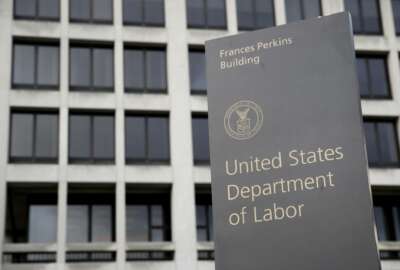
Pandemic broke down some, but not all barriers for IGs
The Association of Government Accountants will release its 10th annual survey of inspector generals in the coming months with a focus on the impact of the pandemic...
Best listening experience is on Chrome, Firefox or Safari. Subscribe to Federal Drive’s daily audio interviews on Apple Podcasts or PodcastOne.
The 10th annual survey of inspectors general changed in two major ways.
First, AGA (formerly known as the Association Government Accountants) focused entirely on the impact of the pandemic on the oversight community. Second, AGA brought in more state and local oversight executives because of how closely they worked with federal officials over the last two years.
Ann Ebberts, the CEO of AGA, said the biggest challenge that emerged from the survey was about data sharing across the different organizations. She said the recognition that federal, state and local auditors could work faster and smarter if agencies and Congress removed some of the major roadblocks to sharing data.
 “The biggest challenge is integrating these analytics capabilities. This agile oversight, this collaboration, these new communication channels and relationships, integrating that into the way oversight is performed in the future is really the challenge,” Ebberts said in an interview about the draft survey results at AGA’s Fraud 2022 conference in Washington, D.C. “I was surprised when I heard that the initial sets of data that came from USAspending.gov, which has been around since 2014 or so, and continues to grow. But even Treasury says that USA Spending doesn’t have all accurate data. So they can only use what is provided to them. I think there are new tools that are being leveraged. It’s getting people on board with understanding the power of those new IT tools, whether machine learning or something else, it takes time and you need to build confidence in what those responses are before you can really act legally on them.”
“The biggest challenge is integrating these analytics capabilities. This agile oversight, this collaboration, these new communication channels and relationships, integrating that into the way oversight is performed in the future is really the challenge,” Ebberts said in an interview about the draft survey results at AGA’s Fraud 2022 conference in Washington, D.C. “I was surprised when I heard that the initial sets of data that came from USAspending.gov, which has been around since 2014 or so, and continues to grow. But even Treasury says that USA Spending doesn’t have all accurate data. So they can only use what is provided to them. I think there are new tools that are being leveraged. It’s getting people on board with understanding the power of those new IT tools, whether machine learning or something else, it takes time and you need to build confidence in what those responses are before you can really act legally on them.”
AGA, and its partner sponsor Kearney and Company, plan to release the final survey results in the coming weeks.
Access to data remains a major obstacle for auditors, even two plus years into the pandemic and the tens of billions in fraud that federal, state and local agencies know about. Justice Department Inspector General Michael Horowitz, who also is the chairman of the Pandemic Response Accountability Committee (PRAC), said one prime example of this problem came from the Labor Department’s unemployment insurance program, which was ripe with fraud during the pandemic.
He said the inability to share social security numbers led to one person applying for UI benefits with the same SSN across 29 states.
Horowitz said this is one of many examples where data sharing could’ve stopped fraud or at least limited it.
To that end, the Labor Department’s IG announced Sept. 22 that it has charged more than 1,000 people with UI fraud. The IG also announced Sept. 21 that its new estimate of UI fraud has reached $45.6 billion particularly across four high-risk areas: people who filed in multiple states, deceased persons, people who filed UI claims with suspicious email accounts and for federal prisoners.
Labor kicked off its effort to modernize state agency unemployment insurance systems last winter, using the $2 billion Congress appropriated in the American Rescue Plan Act.
Removing obstacles slowly
The PRAC, in some cases, had to break down those obstacles.
David Zavada, a senior partner with Kearney and Company, said states were hesitant to share unemployment insurance data so the PRAC ended up subpoenaing the data and now it’s regularly shared. This enables state agencies and federal authorities to check for duplicate social security numbers and similar areas where fraud ran rampant previously.
“I think a lot of the challenges in that area are really getting data that usable, getting clean data and getting data in a format that can be bumped up against other types of data,” he said. “We’re dealing with a lot of systems and those systems are old. They’re antiquated. Even if you get access to data, it’s not always usable.”
Ebberts added the technology underlying these systems to allow for data sharing hasn’t advanced far enough. She said to do sophisticated, timely matching of data to find anomalies and bad actors takes both quality data, advanced technologies and a workforce with the right skill sets.
Zavada said despite the challenges around data, the survey respondents highlighted innovations across the community both around technology and processes improvements.
He said the data challenges also led to improved communication and collaboration across federal, state and local IG communities, which traditionally had been more siloed and less cooperative.
“There were some really great things in terms of the way that they are approaching oversight of pandemic relief programs, and that really had an effect on changing the way those programs are managed,” he said. “They’re introducing these concepts of agile oversight, where they’re reviewing programs and doing risk assessments of programs early on, and getting that information to management in a collaborative way to really affect change early on. We saw that from the CARES Act to the American Rescue Plan Act (ARPA). Initially, those controls that were not in place for the CARES Act, eventually did come into play in ARPA. They started to come back to some of those programs and that reliance on self certification was scaled back a little bit.”
PRAC tools must live on
Another area that emerged from the survey is the ability of IGs to sustain the change brought on by the pandemic.
Zavada said integrating agile oversight, new ways of collaboration and communication, expanded relationships among federal, state and local auditors is going to take a continued focus and effort.
Zavada and Ebberts both pointed to the PRAC’s data analytics platform called the Pandemic Analytics Center of Excellence (PACE) as a key effort that needs to continue. PACE provides the tools and capabilities to help oversee more than $5 trillion in pandemic-related emergency spending by delivering analytic, audit and investigation support to the oversight community.
“The IG community recognizes the problem with the Recovery Accountability and Transparency (RAT) Board disappearing in 2014 or 2015, and not having a base of analytic capability in their hands to meet the needs of the pandemic,” Ebberts said. “They’re already trying to push Congress to give them additional funding or a stream of funding so they can keep that analytic center of excellence going so they could continue to leverage the power of that data and tools, and get other agencies on board with sharing data with them.”
Zavada added if the PRAC had the RAT Board’s data analytics capability in place when the pandemic started, its oversight efforts would’ve accelerated.
Congress decided not to continue to fund the RAT Board’s Recovery Operations Center (ROC) and the Treasury Department absorbed some of the technology and tools, but the PRAC basically had to start from scratch with the PACE.
Ebberts said AGA will continue to share the IG survey results in the coming months with not just federal, state and local auditors, but also with folks outside of the oversight community like CFOs or CIOs.
“We’re trying to make strides. There’s a lot of energy, a lot of passion and a lot of intelligence looking at the data to try to make sure that the fraud that is occurring now doesn’t occur in the future,” Ebberts said. “It’s really like how do you how do we clean up the data? How do we share data effectively, legally, across programs to make sure that we don’t have the amount of fraud that’s going on now in the billions of dollars in the future?”
Copyright © 2024 Federal News Network. All rights reserved. This website is not intended for users located within the European Economic Area.
Jason Miller is executive editor of Federal News Network and directs news coverage on the people, policy and programs of the federal government.
Follow @jmillerWFED
Related Stories

With $2B, Labor Dept. employs two-part strategy to fix unemployment insurance systems
IGs on pandemic oversight board warn job well done still means billions in fraud




